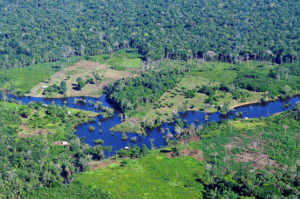
By Michelle Kovacevic, originally published at CIFOR’s Forests News
Local and state government institutions in the jurisdictions where REDD+ (reducing emissions from deforestation and forest degradation) is being implemented are bearing financial burdens, says a study from the Center for International Forestry Research (CIFOR), which might threaten the scheme’s viability to scale up in the coming years.
“This is one of the first studies to characterize the institutions and actors that bear the costs of the sub-national REDD+ initiatives across the tropics. It’s really a reality check,” says Cecilia Luttrell, a senior associate with CIFOR and one of the lead authors of the paper.
“Many REDD+ initiatives have been working under the assumption that the costs of reducing deforestation will be covered by incoming funds from the international community and that REDD+ would also generate a surplus that could be equitably shared between different stakeholders,” she says.
One of the most striking findings is that 84% of subnational government institutions involved in the REDD+ initiatives studied are putting more in than they are getting out of REDD+.
“They may be doing this because they are trying to position themselves to capture future funding streams for REDD+ or because they recognize the local benefits of forest conservation,” Luttrell says.
“But in the short-term, they are bearing real costs.”

The study comes at a critical time for results-based finance, as climate negotiators have started laying the groundwork for execution of the Paris agreement.
The Green Climate Fund is expected to provide important financing for REDD+. A key question facing the Fund’s design is how the price of carbon should be set.
“If the costs of REDD+ are underestimated, then there is a risk that the price set for carbon won’t cover the real costs,” Luttrell says.
The main objective of REDD+ is to provide positive economic incentives to people in developing countries to conserve forests and thereby reduce greenhouse gas emissions. One of the key assumptions of REDD+ is that reducing carbon emissions from deforestation is cheaper than reducing emissions from other sectors, such as transport and energy production. Estimates of REDD+ costs have long been criticized for excluding transaction and implementation costs and undervaluing informal market activities such as subsistence farming.
Everything comes in threes
The total cost to a country of avoided deforestation and degradation can be split into three: opportunity, transaction and implementation costs.
A REDD+ opportunity cost is the profit given up by conserving forests. For example, a family that sells charcoal for a living would lose this income if a REDD+ project stopped them from harvesting timber for charcoal production. Knowing these costs is crucial to calculate what income REDD+ needs to provide so that land users voluntarily stop deforestation. This is typically calculated in US$ per hectare.

A REDD+ implementation cost is the cost involved in starting and running a REDD+ project, including administrative and operational costs. For example, workshops and community consultations that build consensus for the way land will be used will incur salary and transport costs. Implementation costs have been either ignored or oversimplified in policy discussions, partly because uncertainty about REDD+’s design makes them hard to estimate.
A REDD+ transaction cost is the cost of participating in the carbon market. This includes negotiating and legally enforcing contracts, monitoring and verifying carbon storage, and obtaining certification. Transaction costs are perhaps the most challenging to estimate.
“Who bears the costs of REDD+?” is just one of the critical questions addressed in the REDD+ benefits sharing knowledge tree, which aims to help policy makers understand the potential impacts of their decisions on the way benefits from REDD+ are shared.
Luttrell and other CIFOR colleagues have been analyzing subnational REDD+ initiatives since 2009 as part of the Global Comparative Study on REDD+. They’ve repeatedly heard concerns about the costs of REDD+ and about who will bear those costs.
“People are afraid that disadvantaged groups, such as smallholders and those who don’t own land, will not be fully compensated for the opportunity costs they bear,” says Erin Sills, professor at North Carolina State University and lead author of the forthcoming paper.
“Another fear is that REDD+ will become an unfunded mandate for REDD+ country institutions, who will bear substantial but largely unrecognized and uncompensated costs”
“We wanted to know if those fears were well founded.”
WHO BEARS THE BRUNT OF IMPLEMENTATION COSTS?
To determine who has been bearing the brunt of implementation costs, researchers asked 22 REDD+ subnational initiatives to list the institutions that had control over at least 5% of the total budget of the initiative, or had spent at least five days per month on implementation.
“Across these initiatives there were 139 institutions in that list. 60 of these are civil society organizations, 43 are government institutions and only 19 are for-profit companies,” says Sills, who is also a senior associate at CIFOR.
Key informants for each initiative then categorized institutions into three groups:
- Institutions whose costs are fully covered (or possibly receiving a surplus) by the REDD+ initiative budget
- Institutions whose costs are partially covered
- Institutions with multiple roles that are both partially covered and receiving a surplus
Drilling deeper, they discovered some basis for concerns about REDD+ implementation costs falling on developing country institutions, especially local and regional governments. Firstly, no government institutions are involved in implementing REDD+ initiatives that have sold carbon credits. Secondly, of the REDD+ initiatives that have failed or expired, more than a third had implementing institutions from government. Thirdly, less than a quarter of government institutions involved in the implementation of REDD+ are fully covering their costs from REDD+ funding.
“This seems at odds with the expectation that REDD+ will generate benefits that can be shared,” Sills says.
“These numbers tell us that very few actors claim or are perceived to be financially benefitting from REDD+ right now.”
Rather, in these early efforts to roll out REDD+ on the ground, it seems that the challenge has been to fully cover costs, not to decide how to divvy up a surplus.
This is a finding that Rob Dodson knows all too well. Rob heads African Field Operations for Wildlife Works – a private company implementing a portfolio of REDD+ projects across the world.
“The cost of inception of these projects is definitely a limiting factor,” he says. “We are just managing to keep the wolf from the door with our projects and we are probably one of the better funded projects. We are really struggling.”
The researchers then looked at the land uses that are likely to be restricted by REDD+, as well as the stakeholder groups that would be most affected by those restrictions.
“In the initiatives we studied, agriculture and ranching are the most important activities that will be affected by REDD+ implementation, in terms of both the foregone financial profit as well as the number of people affected,” Luttrell says.
Many calculations of opportunity costs have assumed that local people will have secure land tenure with clearly defined and enforced property rights.
“This is a big assumption to make,” Luttrell says, “and can mean you misunderstand the true opportunity costs of local people engaged in traditional activities not formally recognized in the law.”
To understand this better, they classified whether each affected stakeholder group was operating in a legal or illegal manner in terms of tenure.
They found that the land uses from which the greatest number of people benefit tend to be illegal or legally ambiguous: in only six of the REDD+ sites were such land uses clearly legal.
“Perhaps more surprisingly, for more than half of the sites, the most profitable land uses were based on illegal or legally ambiguous tenure,” Luttrell says.
This raises questions about who has legitimate claim on REDD+ revenues: should illegal forest users be entitled to benefits?
CALCULATING COSTS
The Wildlife Works REDD+ project has been far more expensive than anyone predicted, Dodson says.
“We didn’t know how much it would cost when we first started because we were the first to implement a REDD+ project,” he says.
“We thought we would get [the Kasigau corridor project in Kenya] off the ground for about US$150,000 … but the real cost has been US$600,000 from project inception to credit issue after verification.”
Kasigau is considered a reasonably small REDD+ project (about 200,000 hectares). Many of the REDD+ projects in the pipeline will be implemented at the state or national level (termed ‘jurisdictional’ or ‘nested’ REDD+) and cover several million hectares.
“The cost for these is going to be astronomical, which means it is probably out of reach of a lot of governments,” Dodson says.
CIFOR has worked with sustainability consultancy Starling Resources to develop a spreadsheet that helps project developers calculate the implementation costs of their REDD+ initiatives.
Quantifying the costs across different kinds of initiatives is the next research step for CIFOR, Sills says.
“We are analyzing the financial records of a number of REDD+ initiatives to get a picture of where money has been spent and how this differs across projects and in comparison to expectations of how funds would be spent,” Sills says.
FEARS WELL FOUNDED
Overall, the findings suggest some basis for the fears about REDD+ costs.
As discussions intensify around deciding which actors have a legitimate claim on any ‘benefits’ or compensation from REDD+, it’s crucial to know who is incurring what type of costs.
“But it is clear that, in the short term, compensation or profit are not the only factors that are motivating actors to get involved in REDD+, Luttrell says.
“We need to have a more sophisticated understanding of what causes behavioral change beyond that of short-term financial incentives.”











